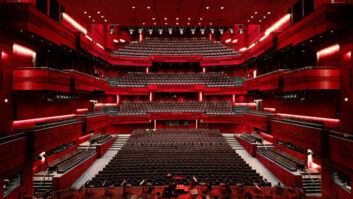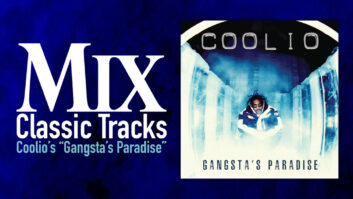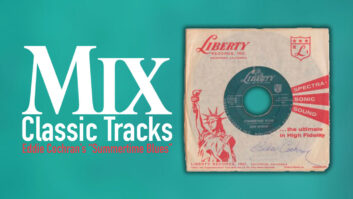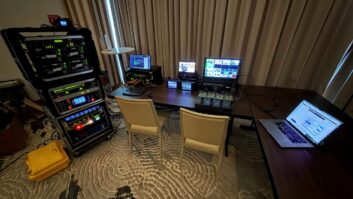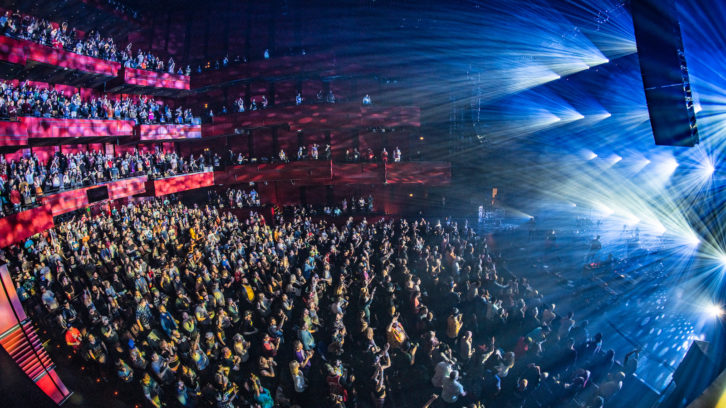
Iceland (June 14, 2022)—Many bands hit the road early this year to make up for lost time, but for Umphrey’s McGee, that meant hitting the ice—or more specifically, Iceland. Back in 2019, the veteran jamband announced “Röckjavik,” a special three-night run at the 1,800-seat Eldborg Concert Hall in Reykjavik, Iceland. Scheduled for March, 2020, the event sold out in three hours, but Covid put everything on the backburner until the concerts finally took place this spring, making for a string of shows that were worth the wait.
“Being a jamband with a large instrumentation, we rarely go over to Europe, just because the expenses are high, but this was a destination event and it’s pretty neat to experience a different country’s way of handling things,” said Chris Mitchell, the band’s FOH engineer since 2011. “The concert hall is a state-sponsored institution and almost no expense was spared in the preparation of the building. It was insane, from the design of the exterior, which is unique, to the way they do sound treatment using the architectural acoustics of the building. They went way over the top in designing it, so it was really nice to go into a place like that. There’s a great Meyer line array, they’re sponsored by DPA Microphones and they had the same Midas Pro X consoles that we carry on tour, so it was really the best of all possible situations for us to fly into.”
The band and its team arrived fresh from a three-night stand in Aspen, Colo., and immediately made the most of their surroundings. “We all flew in a day early to adjust to the time difference and went directly to the Blue Lagoon—because you have to. We spent the day exploring Reykjavik and then the next morning, it was a comfortable 10am load-in. We weren’t able to carry anything over but guitars, a few keyboards and microphones—no amplifiers and the drum kit was rented locally. Once we got past that first day of doing soundcheck, it was so easy. Our next two days were ‘show up at five in the evening and do a line check.’”
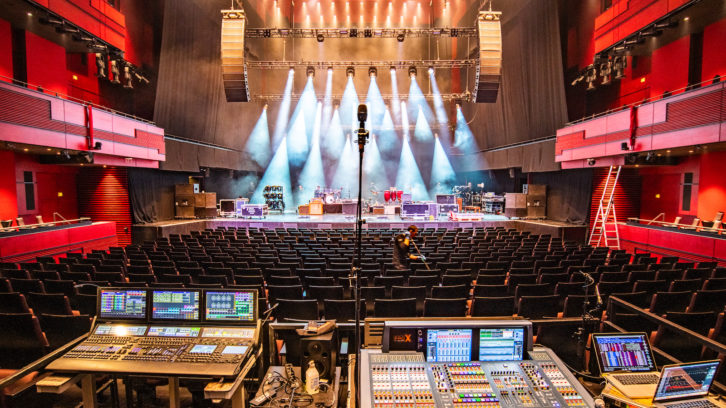
The band typically plays 90 to 105 shows a year, so Umphrey’s McGee owns its FOH and monitor desks, having purchased Midas Pro desks nine years ago. “When the Midas Pro series came out, I was able to hear a few on tour,” said Mitchell. “I think [FOH engineer] Garry Brown from Phish had the first Pro 9 that I heard, and I was just blown away with the tonality of the console. It was like a 144-channel version of a Heritage 3000—how could you go wrong with that? I talked the band into buying them, and they have been paid off for a long time. They’re the core part of my sound, and I’m really happy with what they’ve done for us.”
Given that Eldborg Concert Hall had the same desks in-house, prepping was just a matter of Mitchell and Robert Ston, the band’s monitor engineer since 2000, loading their usual show files. The six-member band—drummer, percussionist, two guitarists, bass player and a keyboard player—generates 64 inputs, with Ston and Mitchell each grabbing what they need. At stageside, Ston oversees his own Midas Pro console, sending mixes to the group’s Sensaphonics 3DME in-ear monitors and a lone sub for the drummer.
To capture all those inputs, Mitchell made a point of bringing along a passel of microphones—a move that ironically brought the rhetorical question of “what microphones would you bring to a desert island” into the real world. The answer: “As many Earthworks as I could fit in my Pelican case. Everything I put them on, I get an exact representation tonally and impulse response-wise. Just the immediacy of the tone and the in-your-face closeness that I can get out of them, I can’t get out of other mics. So, my desert island microphone? Earthworks SR25. If you want to make a list, I’d just go down their product list.”
Umphrey’s McGee Shares Mix With Fans
Mix-wise, Mitchell goes light on effects; while his outboard rack sports three TC Electonic mainstays—a D-Two, Fireworx and Helicon vocal processor—and an Eventide Eclipse, they’re on-hand solely to replicate effects on familiar tracks or to beef up backing vocals. On paper, the dimensions of the opulent Eldborg Concert Hall look like a space that would cause issues with delays and reverberation, but that wasn’t the case, said Mitchell: “It’s been awhile since I’ve mixed a rectangular room with that much height—the ceiling was 110 feet off the stage—but the way the acoustics were designed and treated, it was like standing inside of a reverb algorithm on a TC 6000. When he hit the snare drum, that decay was perfect.”
Some of that was due to the venue’s system of adaptable physical acoustics, which adjusts hall reverberation using hidden chambers, overhead canopies and movable soft goods, but the in-house Meyer Sound P.A. and Galileo loudspeaker management system was hard at work, too. The main left and right hangs each have 10 Mica line array loudspeakers backed by five 600-HP subwoofers, while a center hang sports eight Mica loudspeakers. Placed on the same frame as that center hang are 10 point-source loudspeakers of CQ-1s, CQ-2s and UPA-1Ps, all arrayed beside, below and behind the Micas for side fill, down fill, and rear choir fill. Elsewhere, four UPJunior VariO loudspeakers handle balcony fill, while 14 more UPJunior loudspeakers provide front fill and two CQ-2 loudspeakers handle corner fill.
All that coverage meant that Mitchell spent little time dealing with the P.A.: “I pulled up Smaart and ran a curve trace on it, pulled 3 dB at 160 and then forgot about the P.A. completely; it just disappeared like it wasn’t even in the room. It took me almost an hour, but I walked every balcony, and the coverage is smooth, tonally correct and spread perfectly on everywhere you could put a seat.”
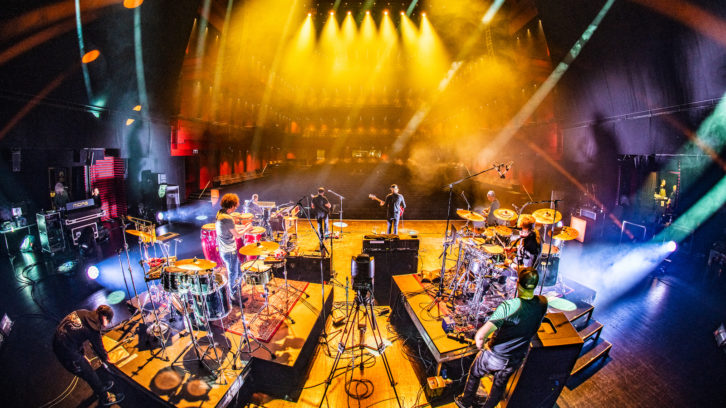
While 1,800 fans made it to Iceland, thousands more have heard the shows performed there thanks to the band’s habit of recording every show and posting it to audio subscription service nugs.net. “I take the left-right off the console, add audience mics to it, pass it through a limiter and that’s the recording,” said Mitchell. “There is no multitrack mixdown afterward; I don’t even go back and tonally adjust things. Part of that is because the mix is kind of down and sounds really good, but the other part is that if we get it up quickly, a lot of fans will pay the $10 to download it, so we turn the shows around very quickly. Last night, the show ended at two and the recording was up by four, so on the way home from the hotel, you can relive the moment that you just had, and if you didn’t make it to the show, you can immediately hear what happened. Since January 31, 2011, I personally have published over 1,000 shows—so all my work is out there for review and critique.”
The Icelandic shows went well, and now Umphrey’s McGee returns to the road this month with a steady string of shows through October. “And it’s filling up, even into the breaks in between,” said Mitchell. “Now that COVID has eased up, all the festivals and venues that we have played before are calling us back—we’re going to be pretty busy from this point forward!”
